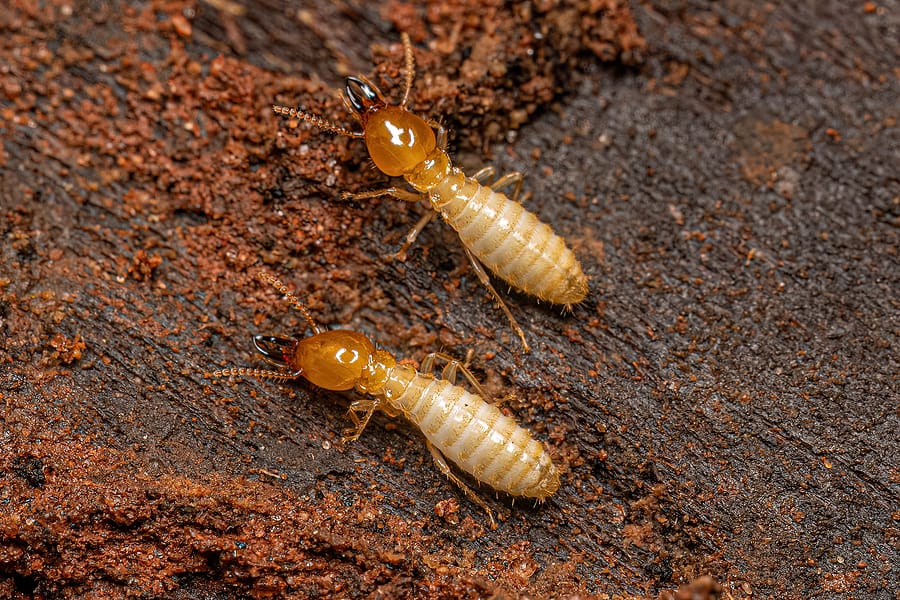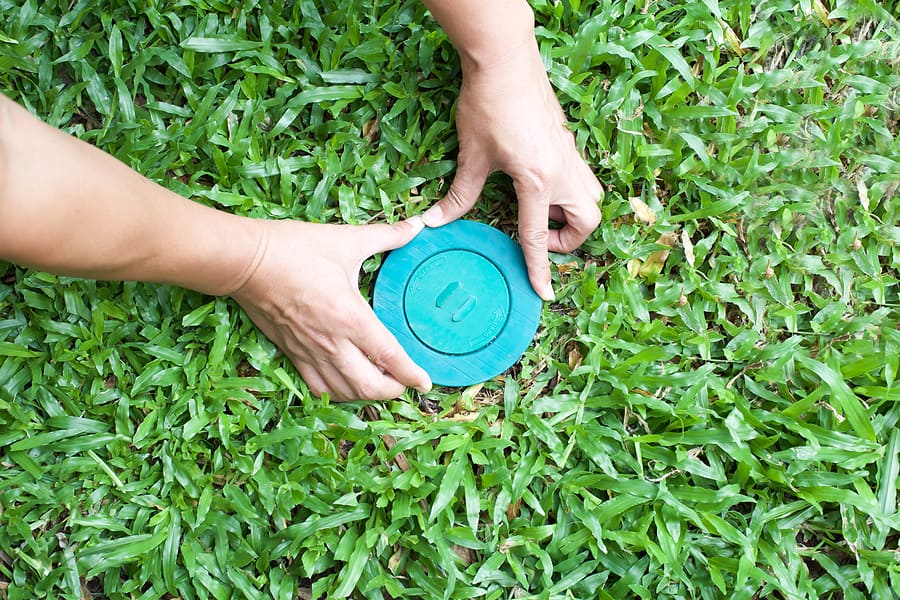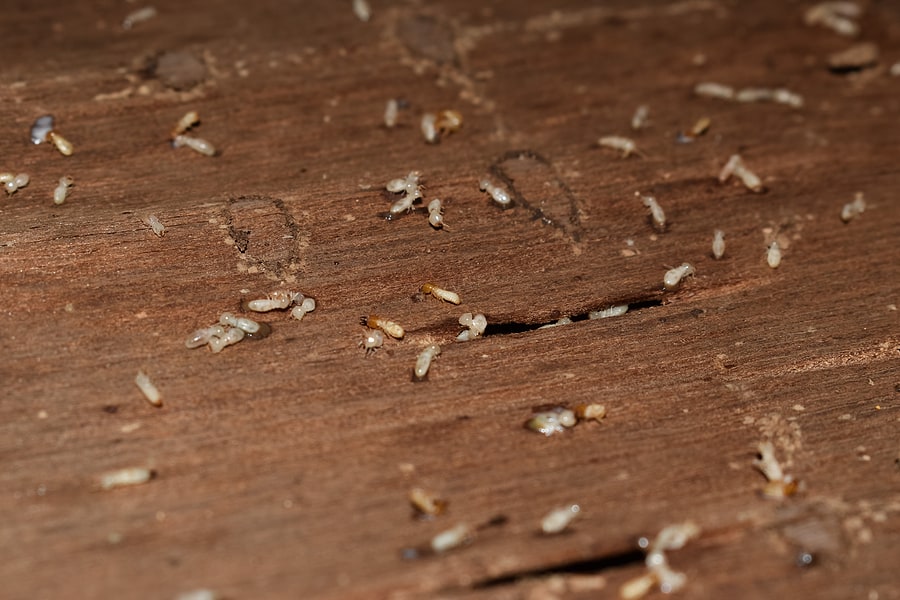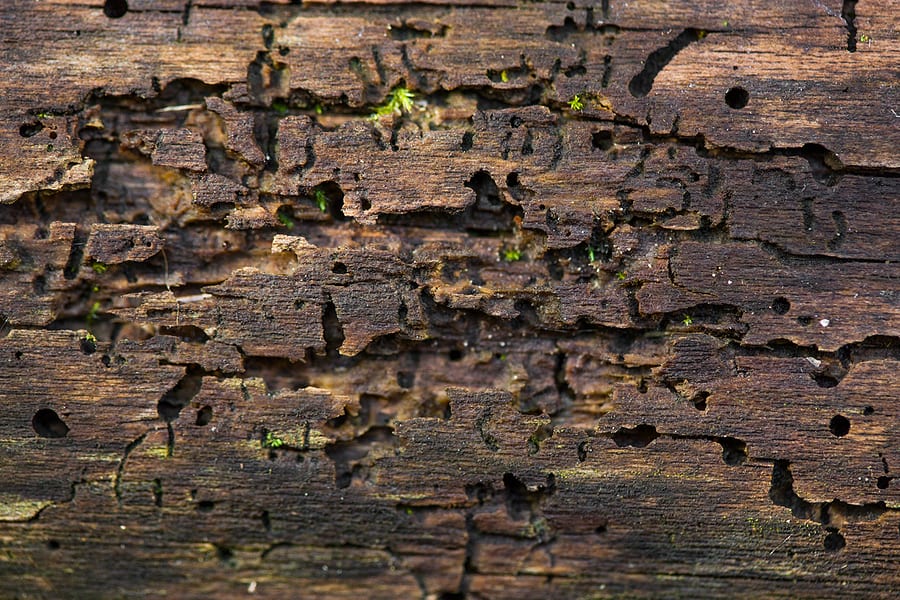READY TO GET STARTED?
REQUEST A FREE ESTIMATE
Fill out the form below or call (888) 466-7849 for a free, no-obligation estimate.

Termites are so destructive because they eat wood from the inside out, often going long periods of time before they are discovered. For this reason, annual termite inspections are critical to protecting your home. These inspections help spot signs of termites sooner, allowing termite control to be implemented earlier in the termite infestation.
There are several different options when it comes to termite treatments. Here are four of the most popular:
Liquid-soil termite treatments are applied to the soil around your home to act as a treatment barrier. They last for an average of 5 years. A trench is dug around the perimeter of your home, and liquid termiticide is applied. The trench is then filled in. This method helps to prevent future infestations while also killing any existing termites as they travel between your home and their nests.
Bait station treatments are another option for termite control. Bait stations are strategically placed around your home using this method. Each station contains a slow-acting termiticide that the termites take back to their nests and share with other termites. These treatments may take longer to work on termites. They also necessitate regular monitoring and maintenance to ensure that each station contains bait.
Wood treatments are an additional termite control option. These treatments make use of either surface sprays and treatments or injected sprays and foams. Wood treatments kill existing termites while also penetrating the wood to prevent future problems. These treatments necessitate direct access to infested wood, which can be difficult to obtain in some cases. Sprays are better for new construction treatments because the wood can be treated while the house is being built. Injected foams are better for use on existing structures because they can expand into cracks and crevices that sprays may not be able to reach.
Pre-treated building materials are ideal for new construction. The termiticide can be sprayed or brushed on. Termiticide can also be applied anywhere the new structure comes into contact with the soil, allowing the soil to be pretreated. Using pressure treated wood is another option because termites are less likely to infest wood that has been treated with chemicals.
While these termite treatment options are efficient at eliminating existing infestations, unfortunately they do not provide permanent elimination of termites. There is always a risk that termites will return to invade again. Termite control is an ongoing process, requiring persistent maintenance and prevention techniques to continue to keep them out.
You can prevent termites by:
Contact your local pest control company for a thorough evaluation.
How to Keep Spring Wildlife Out of Your Home
How Dangerous Is The Water Moccasin?

Subterranean and drywood termite types are popular within the Coral Springs area, looking for homes for their next meal! Termites are year-round pests, making it essential for every South Florida homeowner to be on top of termite control. Check out the top 5 ways you can prevent termites from invading your home and causing billions of dollars in repairs!
If you’re keeping wood stacked against your house, you could be leading termites right inside your home! Leaving woodpiles near your home is not only a great source of food for termites, but it also gives them a safe passage into your home. To avoid the risk of a termite infestation, don’t store any type of wood products in your crawlspace and stack your woodpiles at least 20 feet away from your home. For extra precautions, consider placing wood in a sealed plastic container with a lid and elevating it off the ground.
Termites need moisture to survive, and if there’s any improper drainage in or around your home, you create the ideal environment for them to thrive. Inspect your downspouts and divert water away from your home. Regularly check that your faucets and A/C drip lines are not causing water to pool around your foundation.
Did you know wood mulch is a major termite attractant? It’s true that wood mulch can be a great landscaping tool, but it is known to contain moisture that attracts termites. If you’re using mulch, keep it at least four inches away from your foundation. Likewise, make sure it never contacts the home’s siding, window frames, or door frames. Sometimes an overlooked reason for a termite infestation is clogged gutters. Clogged gutters containing debris will collect moisture, attracting termites. It’s important to remove debris and clean your gutters on a regular basis to avoid backup.
Trees hanging over your home and overgrown bushes can create the perfect shelter area for termites. These areas will often cause moisture to build up and provide an area to build their colony. Avoid termites utilizing your landscape by regularly maintaining it and keeping your trees and shrubs trimmed on a regular basis.
While the above can help make your home less attractive to termites, the best and most effective way to avoid termites is to do a home inspection and regular termite treatments. There are several termite treatment options, such as bait stations, liquid-soil treatments, and spray/foam treatments. It’s best to contact your local Coral Springs pest control company to provide you with a thorough termite inspection and recommended termite control plan that works best for your situation.

Termites are household pests that can cause significant damage in a short amount of time, leaving homeowners with costly repairs. In fact, most homeowner’s policies do not cover termite damage. There are two major types of termites that cause damage to homes: subterranean termites and drywood termites. The type of termite you are dealing with, along with the size of the colony and extent of the damage all determine what type of termite treatment will be most effective. Preparation of your home will depend on which treatment will be performed.
For liquid-soil treatment, a trench is dug around the perimeter of your home where termiticide is applied and then filled back in. For this type of treatment, no preparation is required.
Bait stations are strategically placed in the ground around your home. These treatments also do not require any preparation.
Fumigant treatments are the most extensive and also require you to prepare your home prior to treatment. During fumigation, a tent will be placed over your home and gas will be released, killing any termites that are present, even those in hard to reach areas. You can get your home ready for fumigation by:
Termites can be difficult to get rid of once an infestation has established. Contact your local pest control company for a termite inspection and appropriate treatment options.
Rodents to Lookout for this Winter
Are Spiders More Common In Winter?
When Does Swarming Season Begin?

Termites are highly destructive household pests, causing billions of dollars in damages to homeowners annually. Most homeowner’s policies don’t cover termite damage. What options do homeowners have to protect themselves from these pests?
Two options that are available are a termite warranty and a termite bond. These terms are often used interchangeably but they are, in fact, different.
A termite warranty is similar to an insurance policy you take out against termites. It is insured by an insurance company and allows for more coverage against damages. These warranties will also include an agreement for ongoing monitoring and/or maintenance for the length of the warranty term. They also require the termite control company who provides it to treat for termites if they are found on their annual termite inspection during the warranty period. It can also specify if the pest control company will repair any damages from termites or if they will only retreat the home. Some warranties can even be transferred between homeowners (such as during the sale of the home) but others cannot be transferred.
Termite bonds are similar to warranties. The difference between the two is that bonds require the pest control company to hold a specified amount of money in a surety bond.
Some kind of protection against termites and termite damage is beneficial to homeowners. If you are interested in scheduling a termite inspection or taking out coverage against termites, contact your pest control company for more information.

Termites are one of the most destructive pests, causing significant damage to homeowners in the United States each year. Termites often go long periods of time undetected, allowing a termite infestation to proliferate inside your home. But what causes a termite infestation in the first place? What attracts termites to your home?
Termites are attracted to moisture, especially subterranean termites. Damp basements, bathrooms, laundry rooms, kitchens, leaky pipes, and stagnant water around foundations are common areas that termites are attracted to. Rotten or water damaged wood should be replaced immediately. Leaky or broken pipes should also be repaired as soon as they are discovered. Make sure roofs and gutters are cleaned properly and that proper drainage systems are established. Check and repair issues with foundations. Use a dehumidifier to reduce moisture in attics, crawlspaces, basements, and any other rooms where humidity is high.
Termites will feed on just about any type of wood. This includes new wood, painted wood, treated wood, rotted wood, water damaged wood, wood mulch, wallpaper, and shelf paper. As such, care should be taken to reduce access to wood in and around your home. Foliage and mulch should be kept at least 28″ away from foundations. Wood mulch should be replaced with another coverage medium, like rubber mulch or treated cedar. Anywhere wood comes into contact with the sides of your home also provide a bridge termites can use for access. This allows them to make their way inside, even bypassing soil that has been treated with termiticides. Get rid of any vines, trellises, mulch, stumps, firewood, etc. that is close to your home’s foundation. Trim limbs away that touch the roof, as well.
Termites are silent destroyers, eating wood from the inside out, allowing them to establish colonies and infestations before any signs of their presence arise. It is important to recognize the signs of termites so they can be detected earlier before they can cause significant damage. It is also beneficial to have an annual termite inspection performed by a termite control company. These professionals will inspect the interior and exterior of your home, looking for signs of termite activity or previous termite damage. They can then present you with the best termite control options when necessary.
Are Bed Bugs Active in the Winter?
When Is Millipede and Centipede Season?